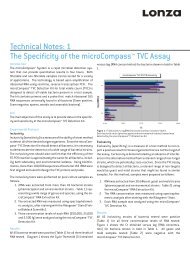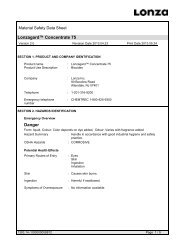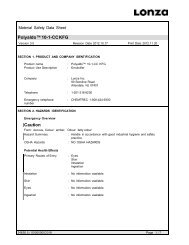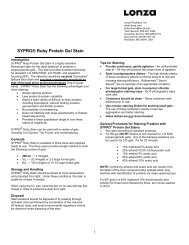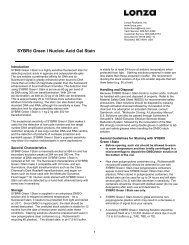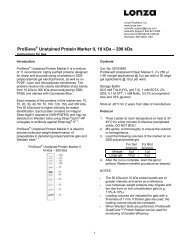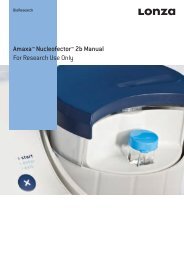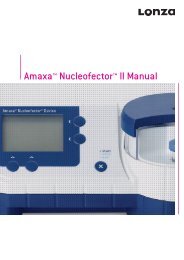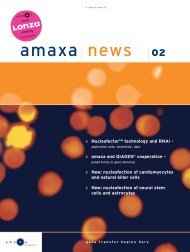Long Ranger® Singel® Packs - Lonza
Long Ranger® Singel® Packs - Lonza
Long Ranger® Singel® Packs - Lonza
You also want an ePaper? Increase the reach of your titles
YUMPU automatically turns print PDFs into web optimized ePapers that Google loves.
<strong>Long</strong> <strong>Ranger®</strong> <strong>Singel®</strong> <strong>Packs</strong><br />
For Automated and Manual DNA Sequencing<br />
<strong>Long</strong> Ranger ® Singel ® <strong>Packs</strong><br />
<strong>Long</strong> Ranger ® Singel ® <strong>Packs</strong> are designed to reduce<br />
gel preparation time and provide run-to-run<br />
consistency, while offering long, high accuracy reads.<br />
Researchers typically observe a 25%-30% increase in<br />
read length over standard polyacrylamide and an<br />
increase in base calling accuracy on automated<br />
sequencers. <strong>Long</strong> Ranger ® Singel ® <strong>Packs</strong> are<br />
compatible with all dye chemistries and are optimized<br />
for use on the ABI Prism ® 377 and 373, Li-Cor ® and<br />
ALFexpress ® Automated DNA Sequencers.<br />
<strong>Long</strong> Ranger ® Singel ® <strong>Packs</strong> are safe to handle. All<br />
components necessary for casting a single gel are<br />
conveniently premeasured and packaged in a ready-touse<br />
pouch. Each component is quality assured to ensure<br />
reproducibility and consistency from run-to-run.<br />
<strong>Long</strong> <strong>Ranger®</strong> Gel Solution-<br />
<strong>Long</strong> Ranger ® Gel Solution is the core of our sequencing<br />
and genotyping product line. Due to its patented gel<br />
formulation, <strong>Long</strong> Ranger ® Gels produce longer, more<br />
accurate reads.<br />
AccuGENE ® TBE Buffer- Prepared from the same<br />
qualified reagents used to produce our Gel Solutions,<br />
liquid concentrates are quality tested to ensure lot-to-lot<br />
consistency.<br />
Precautions<br />
Handling and use of <strong>Long</strong> Ranger ® Singel ® <strong>Packs</strong> are<br />
identical to conventional acrylamide solutions. Wear<br />
gloves and use all safety precautions required for<br />
handling acrylamide solutions. Please read the<br />
material safety data sheets (MSDS) prior to use.<br />
These products are for Research Use Only and not<br />
intended for diagnostic or human use.<br />
Storage Conditions<br />
<strong>Long</strong> Ranger ® Singel ® <strong>Packs</strong> should be stored at room<br />
temperature away from direct sunlight. Singel <strong>Packs</strong><br />
should be used before the expiration date on the<br />
packaging.<br />
1<br />
<strong>Lonza</strong> Rockland, Inc.<br />
www.lonza.com<br />
biotechserv@lonza.com<br />
Tech Service: 800-521-0390<br />
Customer Service: 800-638-8174<br />
Document # 18694-1007-05<br />
Rockland, ME 04841 USA<br />
ABI Automated DNA Sequencers<br />
Catalog<br />
Number<br />
377-36 cm<br />
Sequencing<br />
GeneScan<br />
373-34 cm<br />
Sequencing<br />
GeneScan<br />
377-48<br />
cm<br />
373-<br />
48 cm<br />
50691 50693 50686 50692<br />
Total Volume 50 ml 75 ml 50 ml 75 ml<br />
Urea 6 M 7 M 6 M 8.3 M<br />
<strong>Long</strong> Ranger 5% 5.75% 4.75% 5%<br />
TBE 1X 1X 1X 1X<br />
APS 0.05% 0.05% 0.05% 0.05%<br />
TEMED 0.07% 0.07% 0.07% 0.07%<br />
Manual and other DNA Sequencers<br />
Catalog<br />
Number<br />
LI-COR<br />
0.25 mm<br />
thick gels<br />
33 or 41 cm<br />
AP Biotech<br />
ALFexpress<br />
Manual<br />
50689 50685 50694<br />
Total Volume 50 ml 75 ml 50 ml<br />
Urea 7 M 7 M 7 M<br />
<strong>Long</strong><br />
®<br />
Ranger<br />
6% 5.75% 5.75%<br />
TBE 1.2X 1X 1X<br />
APS 0.067% 0.05% 0.05%<br />
TEMED 0.067% 0.07% 0.07%
AccuGENE ® 5X and 10X TBE Buffers<br />
Liquid Concentrate for Automated DNA<br />
Sequencing<br />
Prepared from qualified reagents which are used in the<br />
<strong>Long</strong> Ranger ® Product Line, the AccuGENE ® 5X and<br />
10X TBE Liquid Concentrates are quality tested to<br />
ensure lot-to-lot consistency.<br />
Specifications<br />
Components<br />
5X<br />
0.445 M Tris Base<br />
10X<br />
0.89 M Tris Base<br />
0.445 M Boric Acid 0.89 M Boric Acid<br />
0.01 M<br />
0.02 M<br />
Na2EDTA•2H2O Na2EDTA•2H2O<br />
18 MΩ water 18 MΩ water<br />
Filtered 2 µm 2 µm<br />
Conductivity 3.14-3.50 mS/cm 3.80-5.06 mS/cm<br />
pH 8.25-8.38 8.0-8.5<br />
Storage* 18°C-24°C 18°C-24°C<br />
*TBE buffers are stable for up to 3 months from date<br />
of manufacture when stored out of direct sunlight.<br />
For Best Results using <strong>Long</strong> Ranger ® Singel ®<br />
<strong>Packs</strong><br />
• Store <strong>Long</strong> Ranger ® Singe ® l<strong>Packs</strong> at room<br />
temperature away from direct sunlight.<br />
• Follow the recommended mixing times for the <strong>Long</strong><br />
Ranger ® Singel ® <strong>Packs</strong>. Under-mixing will result in<br />
inadequate gel polymerization and over-mixing will<br />
result in non-polymerization.<br />
• Ensure the glass plates are thoroughly clean and<br />
dust free. Glass plates can accumulate fluorescent<br />
contaminants from many sources including<br />
detergents, marker pens, ethanol and other solvents,<br />
poor quality water, and hands or gloves. These<br />
invisible contaminants can seriously affect data<br />
collection.<br />
• Once the gel is polymerized (approximately 30<br />
minutes), place paper towels soaked in<br />
electrophoresis buffer over the ends of the plates and<br />
then cover with plastic wrap. This will prevent<br />
moisture loss as the polymerization process<br />
continues. Wrapped gels may be stored at 4°C<br />
overnight.<br />
• New matrix files may need to be prepared for ABI<br />
machines when changing reagents or dye sets.<br />
Protocol for <strong>Long</strong> Ranger ® Singel ® <strong>Packs</strong><br />
Gel Preparation<br />
1. Assemble glass plates and spacers in the cassette<br />
following the method described in your automated<br />
sequencer’s manual.<br />
2. Use the <strong>Long</strong> Ranger ® Singel ® Pack appropriate for<br />
your sequencer and plate length<br />
(See Table on page 1).<br />
2<br />
3. Remove the BLACK clip and mix the contents of the<br />
compartments by hand thoroughly, but gently, for 1<br />
minute.<br />
4. Place the pack on an orbital shaker for 5 minutes at<br />
medium speed.<br />
5. Mix by hand thoroughly but gently for 1 minute.<br />
6. Place the pack on an orbital shaker for 5 minutes at<br />
medium speed.<br />
7. Proceed to Gel Casting.<br />
NOTE: Do not overmix. This may interfere with gel<br />
polymerization.<br />
Gel Casting<br />
The following steps must be completed without<br />
delay.<br />
1. Remove only the RED clip and mix the contents of<br />
the compartments well by hand for 1 minute.<br />
2. Remove the WHITE clip to expose the filter to gel<br />
solution.<br />
3. Hold the pack so the contents drain into the filter end.<br />
Fold the pack in half at the indicated line.<br />
4. Hold the pack with the filter at the top and cut the<br />
pouch on the embossed line across the filter port.<br />
5. Avoid introducing air into solution after mixing. Cast<br />
gel and insert comb according to your standard<br />
procedure.<br />
6. Once the gel is polymerized (approximately 30<br />
minutes), place paper towels soaked in<br />
electrophoresis buffer over the ends of the plates and<br />
then cover with plastic wrap. This will prevent<br />
moisture loss as the polymerization process<br />
continues.<br />
7. Allow 2 hours for complete gel polymerization.<br />
NOTE: Empty <strong>Long</strong> Ranger ® Singel ® <strong>Packs</strong> can<br />
be disposed of in regular trash.<br />
Electrophoresis and Fragment Analysis with<br />
ABI Automated DNA Sequencers<br />
Preparing for Electrophoresis<br />
1. Remove the comb and wash the plates as described<br />
in the ABI Automated Sequencer Manual.<br />
2. Prepare a sufficient quantity of electrophoresis buffer<br />
to fill both anodal and cathodal chambers by diluting<br />
10X TBE stock with deionized water to 1X.<br />
3. Mount the gel cassette onto the sequencing<br />
apparatus according to the manufacturer’s<br />
instructions.<br />
4. To assure plates and gel are clean, perform the Plate<br />
Check module specific to the dye set you are using.<br />
NOTE: Prepare an analysis matrix standard file for<br />
<strong>Long</strong> Ranger ® Gel Solution as described in the<br />
appropriate ABI Prism ® Automated Sequencer<br />
Manual (377 or 373A).
ABI Prism ® 377 with 36 and 48 cm Plates<br />
1. Prepare sample sheet as normal.<br />
2. Pre-run the gel using the desired module until a<br />
temperature of 51°C is achieved, approximately 10-<br />
20 minutes. Do not pre-run longer than necessary to<br />
reach 51°C.<br />
3. Prepare DNA samples as you would for standard<br />
automated sequencing gels.<br />
4. After pre-run is complete, pause the instrument and<br />
rinse the wells thoroughly with electrophoresis buffer.<br />
5. Load samples as described in the ABI Automated<br />
Sequencer Manual.<br />
6. Run the gel using the desired module. Run time will<br />
be 2 hours. In some cases, a 2.5 hour run time may<br />
be necessary to visualize all fragments.<br />
7. Analyze data as usual.<br />
ABI 373A with 48 cm Plates<br />
1. Set the run parameters to 48-cm run length, full scan<br />
mode, 4.0% gel type, 31W power and 16-18h<br />
collection time. Set the parameters for the data<br />
collection software as usual.<br />
2. Pre-run the gel for 10-20 minutes, then press “abort<br />
run” to stop the pre-run. Rinse the wells thoroughly<br />
with electrophoresis buffer.<br />
3. Load samples as described in the ABI Automated<br />
Sequencer Manual.<br />
4. Immediately after loading the last sample, press<br />
“resume run” and start data collection as usual.<br />
5. Analyze data as usual.<br />
ABI 373A with 34 cm Plates<br />
1. Set the run parameters to 34-cm run length, full scan<br />
mode, 4.75% gel type, 30W power and 16h collection<br />
time. Set the parameters for the data collection<br />
software as usual. Follow steps 2-5 above.<br />
Electrophoresis with LI-COR ® Automated<br />
Sequencing Systems<br />
Preparing for Electrophoresis<br />
1. Prepare a sufficient quantity of running buffer to fill<br />
anodal and cathodal chambers by diluting 10X TBE<br />
stock to 1X with distilled water.<br />
2. Remove the comb, and rinse the wells or top surface<br />
of the gel with electrophoresis buffer.<br />
3. Mount the cassette into the sequencing apparatus<br />
according to the manufacturer’s instructions.<br />
3<br />
Electrophoresis Conditions<br />
Parameter<br />
33 cm Standard<br />
Protocol<br />
41 cm Standard<br />
Protocol<br />
Data Collection<br />
Config file<br />
Quick<br />
33-cm-STD.col 41-cm-STD.col<br />
SequencIR<br />
Config file<br />
Quik33cm.col Quik41cm.col<br />
Voltage 1500 volts 1500 volts<br />
Current 35.0 mA 35.0 mA<br />
Power 45.0 watts 31.5 watts<br />
Temperature 50°C 50°C<br />
Scan Speed<br />
3 (=2.4<br />
frames/hr)<br />
3 (=2.4 frames/hr)<br />
Pre-run time 20-30 minutes 30 minutes<br />
Frames to<br />
Collect<br />
25 25<br />
Electrophoresis with the Pharmacia ALFexpress ®<br />
DNA Sequencing System<br />
Preparing for Electrophoresis<br />
1. Prepare a sufficient quantity of running buffer to fill<br />
both anodal and cathodal chambers by diluting 10X<br />
TBE stock to 0.5X.<br />
2. Remove the comb and rinse the wells or top surface<br />
of the gel with electrophoresis buffer.<br />
3. Mount the gel cassette onto the sequencing<br />
apparatus according to the manufacturer’s<br />
instructions.<br />
Electrophoresis Conditions<br />
ALFexpress ®<br />
Parameter Value<br />
Voltage 1500 Volts<br />
Current 60 mA<br />
Power 25 Watts<br />
Temperature 55°C<br />
Sampling Interval 2 seconds<br />
Gel Thickness 0.3 mm and 0.5 mm<br />
Run Time 15 hours
Tips and Troubleshooting for Automated<br />
Sequencing<br />
Please consult your instrument instruction manual for<br />
tips concerning machine operation.<br />
Polymerization<br />
The rate of polymerization and properties of the gel<br />
depend on the quality and concentration of reagents<br />
used and attention to detail. Slow polymerization will<br />
cause gels to be more porous and weak. Fast<br />
polymerization will result in an increase in gel turbidity<br />
and decrease in gel elasticity.<br />
It is important to note that polymerization continues<br />
long after visible gelation occurs. Gelation should occur<br />
within 15-20 minutes and complete polymerization will<br />
occur in approximately 2 hours.<br />
• Do not mix more than 3 gels at once.<br />
• Follow the mixing instructions carefully.<br />
• Allow gels to polymerize for 2 hours prior to use.<br />
Mixing Protocols: Timing and Temperature<br />
Temperature has a direct effect on the rate of<br />
polymerization and properties of the gel. If the<br />
temperature is too high, polymerization will occur very<br />
rapidly and gels will be elastic. If the temperature is too<br />
low, polymerization will be slow and gels will be very<br />
porous.<br />
• To ensure gel-to-gel consistency, pour gels at the<br />
same temperature.<br />
• The optimal temperature for gel polymerization is<br />
23°C-25°C.<br />
• Polymerization is also highly dependent on timing,<br />
and short mixing time may result in a solution that is<br />
too cold for efficient initiation of polymerization. The<br />
pack should be at room temperature when the first<br />
clip is removed. Dissolution of urea is endothermic,<br />
and results in a drop in temperature of the pack<br />
during the first few minutes of mixing. In the twelve<br />
minutes allowed, the pack should return to room<br />
temperature after the powders are in solution.<br />
Extremely low ambient temperatures may slow<br />
polymerization.<br />
• The timing of these processes is very important since<br />
the APS/TEMED reaction is short lived. A total of<br />
twelve minutes is allowed for the urea to dissolve and<br />
the package to return to room temperature. If there is<br />
a long delay between removing the pouch clips,<br />
polymerization may occur very slowly, making a poor<br />
gel after several hours, or there may be no<br />
polymerization at all.<br />
Glass Plates<br />
Use of perfectly clean apparatus and glassware is<br />
critical. In busy labs, it is easy to overlook details like<br />
dishwashing. In high throughput labs where each set of<br />
plates is used many times per week, frequent inspection<br />
of the plates is particularly important. The care applied to<br />
these tasks will be highly rewarded. Several aspects of<br />
fluorescent sequencing may be affected by the condition<br />
of the glass plates. Glass plates may accumulate<br />
4<br />
fluorescent contaminants from detergents, marker pens,<br />
ethanol or other solvents, poor quality water, greasy<br />
hands or gloves etc. This is not visible to the eye but<br />
may seriously affect data collection 1 .<br />
• Glass with chipped edges may not fit correctly on the<br />
aligning pins in the ABI Prism ® 377 Automated<br />
Instrument, or may cause problems at casting.<br />
• Do not let used plates dry out before cleaning them.<br />
Dried gel is hard to remove, but very easy when still<br />
moist. Separate the plates and remove the gel by<br />
lifting with paper towels.<br />
• Use 1%-2% Alconox ® detergent and warm water. If<br />
Alconox ® is not obtainable in your region, consult<br />
your local ABI technical staff for a recommended<br />
alternative. Other cleaning agents may leave<br />
fluorescent deposits. Wear clean, rinsed, powder-free<br />
gloves and avoid scratching and scraping the plates.<br />
If tap water is used with Alconox ® , rinse the plates<br />
thoroughly after soaping with distilled or deionized<br />
water.<br />
• Stand clean plates in an A-shaped Plate Drying Rack<br />
(Catalog No: 50641) to air dry, protected from<br />
splashes and dust (e.g. do not place it right next to<br />
the sink). They should look spotless when dry.<br />
Canned air such as Dust-Off ® is useful for removing<br />
minor dust particles just before casting.<br />
• Good dishwashing machines work well for some labs,<br />
but it is important not to let any gel dry onto the plates<br />
before running the machine. Check the washed<br />
plates carefully before use, and reject any plates with<br />
adhering particles or smears.<br />
• Condition of combs and spacers is important: Do Not<br />
use damaged combs or spacers, since gel thickness<br />
or well formation may be affected. Variations in gel<br />
thickness and imperfections in the gel surface of the<br />
wells may cause band distortions that impair<br />
resolution.<br />
• Note that the comb may be warped; the thin, flexible<br />
part may then form a slightly concave upper surface<br />
at the top of the gel. If this happens it is very difficult<br />
to insert the sharkstooth evenly because the teeth at<br />
the sides must be pushed well into the gel before the<br />
central teeth even touch the gel surface. This causes<br />
deformation of the wells at the sides. The tips of the<br />
sharkstooth on a warped comb form a slightly convex<br />
line, making the problem worse.<br />
• Some labs find it useful to treat their glass plates with<br />
2 M NaOH at regular intervals to remove traces of<br />
fluorescent contaminants. Overnight soaking is not<br />
recommended. One or two hours in NaOH, followed<br />
by thorough rinsing with deionized water, is effective.<br />
Be sure to use appropriate caution when handling the<br />
strong alkali.<br />
Storage of the Gel<br />
Polymerized gels may be stored up to 24 hours. To<br />
protect them from drying, after polymerization, cover the<br />
ends with paper towels dampened with 1X TBE buffer,<br />
and wrap with plastic wrap. In warm weather, storage<br />
overnight at 4°C is suggested.
Swelling of the Gel<br />
• Some labs occasionally observe the gel swelling<br />
dramatically out of the top of the plates during<br />
electrophoresis. The swelling is caused by<br />
electroendosmosis, due to electrostatic charge on the<br />
glass surface. In this situation, cleaning with 2 M HCl<br />
is effective.<br />
Electrophoresis Buffer<br />
• TBE solutions should be free of precipitate. If a<br />
precipitate has formed, discard the buffer and<br />
prepare new buffer.<br />
• Filter stock solutions through 0.45 µm filter and store<br />
in glass containers.<br />
• <strong>Long</strong> Ranger ®<br />
Singel ®<br />
<strong>Packs</strong> are not compatible with<br />
Tris-TAPS EDTA (TTE) electrophoresis buffer. Use<br />
our <strong>Long</strong> Ranger ® Gel Solution if a TTE buffer<br />
system is required.<br />
Matrix File – ABI Automated DNA Sequencers<br />
• When you change from one matrix to a different<br />
matrix, we recommend that you make a new matrix<br />
file (instrument file) on your first gel run. You need to<br />
make a separate file for each instrument, as the file is<br />
only valid for the instrument on which it was made.<br />
• Load appropriate matrix standards and follow the<br />
easy instructions in your ABI Users Manual.<br />
Remember, do not run the base caller on the matrix<br />
standard lanes; the new file is made from the raw<br />
data.<br />
• Mobility files cannot be changed by the user. The<br />
files supplied with the sequencer should be used,<br />
unless at some point in the future the instrument<br />
manufacturer creates new files for <strong>Long</strong> Ranger ®<br />
Gels.<br />
Red Rain<br />
Red rain is caused by air bubbles occuring in areas<br />
where the gel is under heat stress. There are two places<br />
in the gel where bubbles can occur: the read area where<br />
the laser impact creates heat, and around the edge of<br />
the upper buffer tray above the front heat plate.<br />
Localized heat in both of these areas cannot be<br />
dissipated away by the front heat plate. Manipulations<br />
that introduce excessive air while casting will result in<br />
gels that are more prone to red rain. <strong>Long</strong> runs at high<br />
temperature or fast laser scan speeds can increase the<br />
chances of red rain appearing towards the end of the run<br />
due to prolonged heat stress. If modules are altered, the<br />
speed of the run and the quality of resolution may be<br />
changed. Increased voltage or temperature may<br />
increase the probability of red rain. Red rain may also be<br />
caused by foreign particles in the gel and the gel drying<br />
out.<br />
• TBE solutions should be free of precipitate and<br />
filtered through 0.45 µm filters.<br />
• Avoid any action that mixes the Gel Solutions with<br />
air.<br />
• Cast gels in a way that avoids the introduction of too<br />
much air into the gel.<br />
5<br />
• Clean plates as suggested in previous Tips for Glass<br />
Plates.<br />
• After gel polymerization, cover the ends with paper<br />
towels dampened with 1X TBE buffer, and wrap with<br />
plastic wrap.<br />
Gel Dropout<br />
Gel dropout is a fading signal around 140 bp - 220 bp.<br />
The plates seem to bind a long polymer which is<br />
released when the gel heats up during the run. Once<br />
released the polymer binds to the OH group of the<br />
migrating DNA and quenches the signal bind.<br />
• The use of glassware dishwashers eliminates gel<br />
dropout. The combination of extremely high water<br />
temperature and prolonged physical agitation in a<br />
dishwasher effectively removes any residue buildup.<br />
• Clean glass plates immediately after the<br />
electrophoresis run.<br />
• Detergents and chemical washes can also be used 1 .<br />
Green or Blue Haze<br />
Green haze in the back of the gel is common. It can be<br />
seen on the image window of the ABI Prism ® 377. It is<br />
not usually strong enough to interfere with the other<br />
bands. It is caused by a buildup of fluorescent materials<br />
on the plates or misaligned plates.<br />
• Soak plates for 20 minutes in 2 M NaOH.<br />
• Clean glass plates immediately after the<br />
electrophoresis run.<br />
• Clean plates as suggested in previous Tips for Glass<br />
Plates.<br />
<strong>Long</strong> Ranger ® Singel ® <strong>Packs</strong> for Manual Sequencing<br />
For Best Results<br />
• Solutions of TBE containing visible precipitate should<br />
not be used. Borate can precipitate out of<br />
concentrated solutions of TBE. This will change the<br />
buffer capacity, ionic strength and the pH of the<br />
solution.<br />
• Follow the recommended mixing times for the <strong>Long</strong><br />
Ranger ® Singel ® <strong>Packs</strong>. Under-mixing will result in<br />
inadequate gel polymerization and over-mixing will<br />
result in non-polymerization.<br />
• Do not use electrophoretic conditions that cause the<br />
gel to become warmer than 50°C.<br />
• Treat only one glass plate with silanizing solution.<br />
Over silanization can cause bubbles during gel<br />
casting, gel swelling during electrophoresis and gel<br />
detachment from the glass plate.<br />
• To minimize gel swelling during fixing, a 20%<br />
ethanol and 10% acetic acid fixing solution<br />
should be used.
Gel Preparation<br />
1. Glass plates must be clean and free of dried gel and<br />
soap residues. To remove residues, apply ethanol to<br />
both plates and wipe dry.<br />
2. Ensure that the gel will not stick to the glass plates by<br />
silanizing only one plate.<br />
3. Assemble glass plates according to manufacturer’s<br />
instructions.<br />
4. Use the <strong>Long</strong> Ranger ® Singel ® Pack appropriate for<br />
manual sequencing.<br />
5. Remove the BLACK clip and mix the contents of the<br />
compartments by hand thoroughly but gently for 1<br />
minute.<br />
6. Place the pack on an orbital shaker for 5 minutes at<br />
medium speed.<br />
7. Mix by hand thoroughly but gently for 1 minute.<br />
8. Place the pack on an orbital shaker for 5 minutes at<br />
medium speed.<br />
9. Proceed to Gel Casting.<br />
NOTE: Do not overmix. This may interfere with gel<br />
polymerization.<br />
Gel Casting<br />
The following steps must be completed without<br />
delay.<br />
1. Remove only the RED clip and mix the contents of<br />
the compartments well by hand for 1 minute<br />
2. Remove the WHITE clip to expose the filter to gel<br />
solution.<br />
3. Hold the pack so the contents drain into the filter end.<br />
Fold the pack in half at the indicated line.<br />
4. Hold the pack with the filter at the top and cut the<br />
pouch on the embossed line across the filter port.<br />
5. Avoid introducing air into solution after mixing. Cast<br />
gel and insert comb according to your standard<br />
procedure.<br />
6. Once the gel is polymerized (approximately 30<br />
minutes), place paper towels soaked in<br />
electrophoresis buffer over the ends of the plates and<br />
then cover with plastic wrap. This will prevent<br />
moisture loss as the polymerization process<br />
continues.<br />
7. Allow 2 hours for complete gel polymerization.<br />
NOTE: Empty <strong>Long</strong> Ranger ® Singel ® <strong>Packs</strong> can be<br />
disposed of in regular trash.<br />
Preparing for Electrophoresis<br />
1. Prepare a sufficient quantity of running buffer to fill<br />
both anodal and cathodal chambers by diluting 10X<br />
TBE stock to 0.6X or 1X with deionized water, as<br />
appropriate.<br />
2. Remove the comb, and rinse the wells or top surface<br />
of the gel with electrophoresis buffer.<br />
3. Mount the gel cassette onto the sequencing<br />
apparatus according to the manufacturer’s<br />
instructions.<br />
6<br />
Autoradiography<br />
1. When the run is complete, turn off the power supply,<br />
disconnect electrodes and remove the plates from<br />
the apparatus.<br />
2. <strong>Long</strong> Ranger ®<br />
Gels do not require fixing or removal of<br />
urea for 35<br />
S labeled reactions. If your application<br />
requires fixing, soak in 20% ethanol and 10% acetic<br />
acid for 10 to 20 minutes.<br />
3. Allow the plates to cool briefly before separating.<br />
Transfer the gel onto Whatman ® 3MM chr filter paper.<br />
4. Place the Whatman ® 3MM chr paper on a flat surface<br />
with gel side up and cover with plastic wrap.<br />
5. Dry the gel (not required for 32<br />
P-labeled gels) under<br />
vacuum at 70°C-80°C for 30-60 minutes.<br />
6. Remove the plastic wrap and expose gel to X-ray film<br />
using standard techniques.<br />
Electrophoresis<br />
1. Pre-run the gel for 10 to 15 minutes before loading<br />
the samples. Use 28 - 35 W for 35 ml gels (40 cm x<br />
20 cm x 0.4 mm) or 55 - 66 W for 70 ml gels (40 cm x<br />
40 cm x 0.4 mm).<br />
2. Prepare DNA samples as you would for standard<br />
sequencing gels: denature samples for 2 to 5 minutes<br />
at 75°C or the temperature recommended for the<br />
enzyme you are using, and immediately chill on ice.<br />
3. After the pre-run, rinse the well(s) thoroughly with<br />
electrophoresis buffer. Reinsert the sharks-tooth<br />
comb so it just touches the gel, and load samples.<br />
4. Adjust the power so that the temperature of the glass<br />
plates is between 40°C - 50°C. We recommend using<br />
28 - 35 W for 35 ml gels and 55 - 66 W for 70 ml gels.<br />
Monitor the temperature of the plates, and adjust<br />
wattage to maintain the desired temperature.<br />
5. Monitor the run time with the marker dyes,<br />
bromophenol blue and xylene cyanol.<br />
Approximate Running Times of <strong>Long</strong> Ranger ® Gels<br />
Bases Read 250<br />
400-500<br />
Pre-run 10-15 minutes 10-15<br />
minutes<br />
>600<br />
(double load)<br />
10-15 minutes<br />
Run Time 2 hours 4 hours 6-8 hours<br />
Dye Migration in <strong>Long</strong> Ranger ® Gels (1X TBE)<br />
Gel % Bromophenol Blue Xylene Cyanol<br />
5 40 bp 175 bp<br />
6 20 bp 138 bp<br />
7 19 bp 123 bp<br />
8 11 bp 98 bp
Tips and Troubleshooting for Manual Sequencing<br />
Polymerization<br />
The rate of polymerization and properties of the gel<br />
depend on the quality and concentration of reagents<br />
used and attention to detail. Slow polymerization will<br />
cause gels to be more porous and weak. Fast<br />
polymerization will result in an increase in gel turbidity<br />
and decrease in gel elasticity.<br />
It is important to note that polymerization continues<br />
long after visible gelation occurs. Gelation should occur<br />
within 15-20 minutes and complete polymerization will<br />
occur in approximately 2 hours.<br />
• Do not mix more than 3 gels at once.<br />
• Follow the mixing instructions carefully.<br />
• Allow gels to polymerize for 2 hours prior to use.<br />
Mixing Protocols: Timing and Temperature<br />
Temperature has a direct effect on the rate of<br />
polymerization and properties of the gel. If the<br />
temperature is too high, polymerization will occur very<br />
rapidly and gels will be elastic. If the temperature is too<br />
low, polymerization will be slow and gels will be very<br />
porous.<br />
• To ensure gel-to-gel consistency, pour gels at the<br />
same temperature.<br />
• The optimal temperature for gel polymerization is<br />
23°C-25°C.<br />
• Polymerization is also highly dependent on<br />
temperature, and short mixing time may result in a<br />
solution that is too cold for efficient initiation of<br />
polymerization. The pack should be at room<br />
temperature when the first clip is removed.<br />
Dissolution of urea is endothermic, and results in a<br />
drop in temperature of the pack during the first few<br />
minutes of mixing. In the twelve minutes allowed, the<br />
pack should return to room temperature after the<br />
powders are in solution. Extremely low ambient<br />
temperatures may also slow polymerization.<br />
• The timing of these processes is very important since<br />
the APS/TEMED reaction is short lived. A total of<br />
twelve minutes is allowed for the urea to dissolve and<br />
the package to return to room temperature. If there is<br />
a long delay between removing the pouch clips,<br />
polymerization may occur very slowly, making a poor<br />
gel after several hours, or there may be no<br />
polymerization at all.<br />
Glass Plates<br />
• Glass plates should be free of dried gel material.<br />
Wash plates immediately after removal of the gel.<br />
• Plates can be washed with a 0.5% solution of<br />
Alconox ® , rinsed with hot water and wiped with<br />
ethanol.<br />
• Dirt and debris on glass plates can cause bubbles to<br />
form during gel casting. Wash plates as described in<br />
the previous bullet point.<br />
• To avoid gel sticking, treat one glass plate with a<br />
silanizing agent (Gel Slick ® Catalog No. 50640)<br />
7<br />
• Over silanization can cause gels to swell between the<br />
glass plates and may cause sample loading<br />
problems. Both plates should be stripped by soaking<br />
in a 2 M NaOH solution for 30 minutes and then recoat<br />
one plate only with a silanizing agent.<br />
Electrophoresis Buffer<br />
Buffer problems can cause a host of gel problems. Some<br />
problems include fuzzy bands, localized heating, smiling,<br />
frowning, wavy bands and slanted bands. A breakdown<br />
in the buffering system can also cause problems at the<br />
interface between the gel and the running buffer. You<br />
may see swelling of the gel out of the top or bottom of<br />
the cassette and an uneven well area.<br />
• TBE solutions should be free of precipitate. If a<br />
precipitate has formed, discard the buffer and<br />
prepare new buffer.<br />
• The use of a discontinuous buffer system is not<br />
recommended.<br />
• <strong>Long</strong> Ranger ®<br />
Singel ®<br />
<strong>Packs</strong> are not compatible with<br />
glycerol tolerant buffer (Tris-Taurine EDTA). Use our<br />
<strong>Long</strong> Ranger ® Gel Solution in these applications.<br />
Electrophoresis Conditions<br />
• <strong>Long</strong> Ranger ® Gels should not exceed a temperature<br />
of 51°C during electrophoresis.<br />
• Gels should be pre-run to a temperature of 45°C-<br />
50°C prior to loading samples.<br />
Fixative Solution<br />
Because of <strong>Long</strong> Ranger ® Solution’s unique structure,<br />
gels will not crack during drying even if they are not<br />
fixed.<br />
• If your protocol requires fixing, use a solution of 20%<br />
ethanol and 10% acetic acid to minimize gel swelling.<br />
• Use the correct fixative as stated above to avoid the<br />
gel from swelling while in the fixative.<br />
• Over-silanization of glass plates can cause the gel to<br />
detach from the plate during fixing. Strip both glass<br />
plates by soaking in a 2 M NaOH solution for 30<br />
minutes and then re-coat one plate only with a<br />
silanizing agent.<br />
Sample Preparation<br />
• Samples should be denatured for 2 to 5 minutes at<br />
75°C-80°C prior to loading on the gel.<br />
• If the sequencing reaction is narrowing near the<br />
bottom of the gel, your sample could contain<br />
excessive salt. Wash the template DNA an additional<br />
time with 70% ethanol.<br />
• If you are using a DNA polymerase with high glycerol<br />
concentration, substitute TTE buffer for TBE buffer<br />
and use our <strong>Long</strong> Ranger ® Gel Solution.
References<br />
1. Applied Biosystems (2001). Cleaning Glass Plates to<br />
eliminate temporary loss of signal. P/N 4306162<br />
2. Applied Biosystems (2001). Achieving longer High-<br />
Accuracy Reads on the 377 sequenser. P/N 4315153<br />
3. Shorr, Robert. (1993). Electrophoretic Media. U.S.<br />
Patent 5219923.<br />
4. <strong>Lonza</strong>, Inc (1998). <strong>Long</strong> Ranger ® Singel ® <strong>Packs</strong> for<br />
automated sequencing [ReSOURCE ® Notes] #01-<br />
0298.<br />
Ordering Info<br />
Part<br />
Number Description<br />
Related Products<br />
Size<br />
Quantity<br />
50691<br />
<strong>Long</strong> <strong>Ranger®</strong> <strong>Singel®</strong>Pack -<br />
ABI Prism® 377-36 cm<br />
5 pack<br />
50686<br />
<strong>Long</strong> <strong>Ranger®</strong> <strong>Singel®</strong>Pack -<br />
ABI Prism 377-48 cm<br />
5 pack<br />
50693<br />
<strong>Long</strong> <strong>Ranger®</strong> <strong>Singel®</strong>Pack -<br />
ABI Prism 373-34 cm<br />
5 pack<br />
50692<br />
<strong>Long</strong> <strong>Ranger®</strong> <strong>Singel®</strong>Pack -<br />
ABI Prism 373 -48 cm<br />
5 pack<br />
50689<br />
<strong>Long</strong> <strong>Ranger®</strong> <strong>Singel®</strong>Pack –<br />
LI-COR® 33 or 41 cm<br />
5 pack<br />
50685<br />
<strong>Long</strong> <strong>Ranger®</strong> <strong>Singel®</strong>Pack -<br />
ALFexpress®<br />
5 pack<br />
50694<br />
<strong>Long</strong> <strong>Ranger®</strong> <strong>Singel®</strong>Pack -<br />
Manual Sequencing<br />
5 pack<br />
50839 AccuGENE® 5X TBE Buffer 4 L<br />
50835 AccuGENE® 5X TBE Buffer 10 L<br />
50836 AccuGENE® 5X TBE Buffer 20 L<br />
50843 AccuGENE® 10X TBE Buffer 1 L<br />
50840 AccuGENE® 10X TBE Buffer 4 L<br />
50837 AccuGENE® 10X TBE Buffer 10 L<br />
50838 AccuGENE® 10X TBE Buffer 20 L<br />
Part<br />
Number<br />
Description<br />
Size<br />
Quantity<br />
50611 <strong>Long</strong> <strong>Ranger®</strong> 50% Gel Solution 250 ml<br />
50615 <strong>Long</strong> <strong>Ranger®</strong> 50% Gel Solution 1 L<br />
50640 Gel Slick® Solution 250 ml<br />
50641 Plate Drying Rack Each For Research Use Only.<br />
8<br />
LI-COR is a trademark of LI-COR, Inc. ALFexpress is a<br />
trademark of Pharmacia Biotech AB Corporation.<br />
Nalgene is a trademark of Nalge Company Corp. Whatman is<br />
a trademark of Whatman Paper Limited Company.<br />
Dust-off is a trademark of Falcon Safety<br />
Products, Inc. Alconox is a trademark of Alconox Corporation.<br />
ABI Prism is a registered trademark of PE Corporation, Applied<br />
Biosystems Division. All other trademarks herein are marks of<br />
the <strong>Lonza</strong> Group or its affiliates.<br />
<strong>Long</strong> Ranger is covered by U.S. Patent #5,219, 923.<br />
© 2007 <strong>Lonza</strong> Rockland, Inc.<br />
All Rights Reserved.



